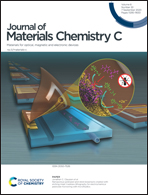Structural and electronic evolution in the Cu3SbS4–Cu3SnS4 solid solution†
Abstract
Cu3Sb1−xSnxS4 samples with 0.0 ≤ x ≤ 1.0 were synthesized from pure elements by mechanical alloying combined with spark plasma sintering. The structural and electronic properties of these compounds were characterized by powder X-ray and neutron diffraction, X-ray photoelectron spectroscopy (XPS), magnetic susceptibility and electrical and thermal transport measurements, and the experimental results compared against those calculated from hybrid density functional theory. A full solid solution is found between famatinite (Cu3SbS4) and kuramite (Cu3SnS4), with low x-value compositions in the Cu3Sb1−xSnxS4 system exhibiting the ordered famatinite structure and compositions above x = 0.7 showing progressive disorder on the cation sublattice. The semiconducting behaviour of Cu3SbS4 becomes increasingly more metallic and paramagnetic with increasing Sn content as holes are introduced into the system. Neutron diffraction data confirm that the sulfur stoichiometry is maintained, while XPS results show Cu remains in the monovalent oxidation state throughout, suggesting that hole carriers are delocalized in the metallic band structure. The order–disorder transition is discussed in terms of the defect chemistry and the propensity towards disorder in these compounds.



 Please wait while we load your content...
Please wait while we load your content...